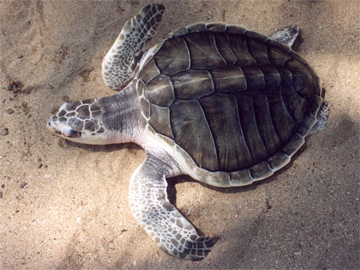

Scientific Name
Lepidochelys olivacea

Conservation status
Vulnerable

Population
Declining

Average lifespan
30 – 50 years

Average adult weight
36 – 43 Kgs

Average adult size
55 – 76 cm

Biogeographic realm
Tropical regions of the Atlantic, Pacific, and Indian oceans
The name Olive Ridley derives from the olive-green tint of its heart-shaped shell. Olive Ridleys resemble Kemp’s sea turtles, and these two are the smallest species of all sea turtles. Olive Ridleys are the most abundant sea turtle among all sea turtles. They have an olive green carapace (with 5 to 9 scutes) on top and a greenish-yellow plastron on the bottom. Each of Olive Ridley’s four flippers has one or two claws. They feed on a varied diet of crabs, jellyfish, clams, snails, and some algae. In the tropically to warm-temperate Pacific and India Oceans as well as the Atlantic Ocean, Olive Ridleys flourish. They reach maturity around 14 years of age. Most Olive Ridleys lay two or three clutches of eggs per year, totaling about 110 eggs. Bycatch in fishing gears, the direct harvest of Turtles and eggs, loss and degradation of nesting habitats, predation of eggs and hatchlings, vessel strikes, ocean pollution, and climate changes are the major threats to the degradation of the Olive Ridley population.

